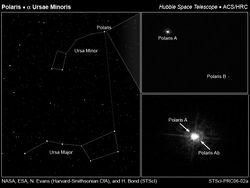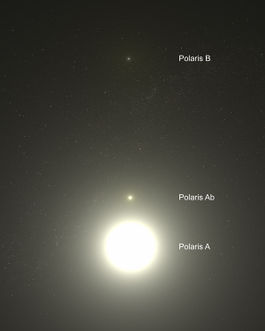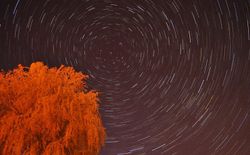Polaris
 Polaris as seen by the Hubble Space Telescope. |
|
| Observation data Epoch J2000 Equinox J2000 |
|
|---|---|
| Constellation | Ursa Minor |
| Right ascension | 02h 31m 48.7s |
| Declination | +89° 15′ 51″ |
| Apparent magnitude (V) | 1.97 |
| Characteristics | |
| Spectral type | F7 Ib-II SB |
| U−B color index | 0.38 |
| B−V color index | 0.60 |
| Variable type | Cepheid variable |
| Astrometry | |
| Radial velocity (Rv) | -17 km/s |
| Proper motion (μ) | RA: 44.22 mas/yr Dec.: -11.74 mas/yr |
| Parallax (π) | 7.56 ± 0.48 mas |
| Distance | 430 ± 30 ly (132 ± 8 pc) |
| Absolute magnitude (MV) | -3.63±0.14[1] |
| Details | |
| Mass | 7.54±0.6[1][2] M☉ |
| Radius | 30 R☉ |
| Luminosity | 2200 L☉ |
| Temperature | 7200 K |
| Metallicity | 112% solar[3] |
| Rotation | ~17 km/s |
| Age | ? years |
| Other designations | |
|
Polaris, Cynosura, Alruccabah, Phoenice, Navigatoria, Star of Arcady, Yilduz, Mismar, Поля́рная звезда́ (Polyarnaya zvyezda), 1 Ursae Minoris, HR 424, BD +88°8, HD 8890, SAO 308, FK5 907, GC 2243, ADS 1477, CCDM 02319+8915, HIP 11767
|
|
Polaris (α UMi / α Ursae Minoris / Alpha Ursae Minoris, commonly North(ern) Star or Pole Star, or Dhruva Tara and sometimes Lodestar) is the brightest star in the constellation Ursa Minor. It is very close to the north celestial pole, making it the current northern pole star.
Polaris is about 430 light-years from Earth and is a multiple star. α UMi A is a six solar mass[4] F7 bright giant (II) or supergiant (Ib). The two smaller companions are: α UMi B, a 1.5 solar mass[4] F3V main sequence star orbiting at a sistance of 2400 AU, and α UMi Ab, a very close dwarf with an 18.5 AU radius orbit. There are also two distant components α UMi C and α UMi D.[5]
Polaris B can be seen even with a modest telescope and was first noticed by William Herschel in 1780. In 1929, it was discovered by examining the spectrum of Polaris A that it had another very close dwarf companion (variously α UMi P, α UMi a or α UMi Ab), which had been theorized in earlier observations (Moore, J.H and Kholodovsky, E. A.). In January 2006, NASA released images from the Hubble telescope, directly showing all three members of the Polaris ternary system. The nearer dwarf star is in an orbit of only 18.5 AU (2.8 billion km;[6] about the distance from our Sun to Uranus) from Polaris A, explaining why its light is swamped by its close and much brighter companion.[7]
Polaris is a classic Population I Cepheid variable (although, it was once thought to be Population II due to its high galactic latitude). Since Cepheids are an important standard candle for determining distance, Polaris (as the closest such star) is heavily studied. Around 1900, the star luminosity varied ±8% from its average (0.15 magnitudes in total) with a 3.97 day period; however the star's heat is at a low level. Over the same period, the star has brightened by 15% (on average), and the period has lengthened by about 8 seconds each year.
Recent research reported in Science suggests that Polaris is 2.5 times brighter today than when Ptolemy observed it (now 2mag, antiquity 3mag). Astronomer Edward Guinan considers this to be a remarkable rate of change and is on record as saying that "If they are real, these changes are 100 times larger than [those] predicted by current theories of stellar evolution."
Contents |
Pole Star

Because in the current era[9] α UMi lies nearly in a direct line with the axis of the Earth's rotation "above" the North Pole — the north celestial pole — Polaris stands almost motionless on the sky, and all the stars of the Northern sky appear to rotate around it. Therefore, it makes an excellent fixed point from which to draw measurements for celestial navigation and for astrometry. In more recent history it was referenced in Nathaniel Bowditch's 1802 book, The American Practical Navigator, where it is listed as one of the navigational stars.[10] At present, Polaris is 0.7° away from the pole of rotation (1.4 times the Moon disc) and hence revolves around the pole in a small circle 1½° in diameter. Only twice during every sidereal day does Polaris accurately define the true north azimuth; the rest of the time it is only an approximation and must be corrected using tables or a rough rule of thumb. The best approximation[11] was made using the leading edge of the constellation Ursa Major as a point of reference. The leading edge (consisting of the star Dubhe) is referenced to a clock face and the Azimuth of Polaris worked out for different latitudes.
Due to the precession of the equinoxes, Polaris will not always be the pole star. Over tens of thousands of years, perturbations to the Earth's axis of rotation will cause it to point to other regions of the sky, tracing out a circle over 25,800 years.[9] Other stars along this circle would have served as the pole star in the past and will again in the future, including Beta Ursae Minoris from 1500 BC to 500 AD, Thuban around 2500 BC and Vega 12000 BC.[9]
Other names for Polaris

Polaris has numerous traditional names: Alruccabah, Cynosura, Dhruv, Phoenice, Tramontana, Angel Stern, Navigatoria, Star of Arcady, Yilduz, Mismar, Gwiazda Polarna, Polyarnaya, Midnight Star. Cynosūra is from the Greek κυνόσουρα "the dog’s tail" and is the source of the English word "cynosure".[12] Yilduz is from the Turkish word for "star" (see Yildun). The most commonly known name (in English) is the Pole Star.
See also
- North celestial pole
- Polaris in fiction
Notes
- ↑ 1.0 1.1 Wieland page 9: Table 5 gives mass of component A as 6.0 ±0.5 and P as 1.54 ±0.25 solar masses
- ↑ Nancy Remage Evans; Gail Schaefer; Bond; Edmund Nelan; Giuseppe Bono; Margarita Karovska; Scott Wolk; Dimitar Sasselov et al. (2006). "Polaris: Mass and Multiplicity". arΧiv:astro-ph/0609759 [astro-ph]. (Evans et al support Wieland's prediction: "preliminary mass of 5.0 ± 1.5 M⊙ for the Cepheid and 1.38 ± 0.61 M⊙ for the close companion.)
- ↑ Cayrel de Strobel, G.; Soubiran, C.; Ralite, N. (2001). " Catalogue of [Fe/H] determinations for FGK stars: 2001 edition ". Astronomy & Astrophysics 373: 159–163. doi:10.1051/0004-6361:20010525. Bibcode: 2001A&A...373..159C.
- ↑ 4.0 4.1 Wieland page 3: masses of A and P ... (6.0+1.54M⊙)
- ↑ Wieland page 2
- ↑ There's More to the North Star Than Meets the Eye
- ↑ Evans, N. R.; Schaefer, G.; Bond, H.; Bono, G.; Karovska, M.; Nelan, E.; Sasselov, D. (January 9, 2006). "Direct detection of the close companion of Polaris with the Hubble Space Telescope". American Astronomical Society 207th Meeting. http://www.aas.org/publications/baas/v37n4/aas207/1130.htm.
- ↑ "SIMBAD Object query : CCDM J02319+8915". Centre de Données astronomiques de Strasbourg. http://simbad.u-strasbg.fr/simbad/sim-id?Ident=CCDM+J02319%2B8915&NbIdent=1&Radius=2&Radius.unit=arcmin&submit=submit+id. Retrieved 2010-06-10.
- ↑ 9.0 9.1 9.2 Norton, Arthur P. (1973). Norton's Star Atlas. Edinburgh: Sky Publishing. p. 10. ISBN 0-85248-900-5. "4500 years ago it was Thuban (α Draconis); 8000 years hence it will be Deneb"
- ↑ Nathaniel Bowditch: The American Practical Navigator, 2002 Bicentennial Ed., Chapter 15 Navigational Astronomy, page 248, Figure 1530a. Navigational stars and the planets
- ↑ A visual method to correct the ships compass using Polaris using Ursa Major as a point of reference [1]
- ↑
 Chisholm, Hugh, ed (1911). "Cynosure". Encyclopædia Britannica (Eleventh ed.). Cambridge University Press.
Chisholm, Hugh, ed (1911). "Cynosure". Encyclopædia Britannica (Eleventh ed.). Cambridge University Press.
References
Wieland, R.; H. Jahreiss, C. Dettbarn, H. Lenhardt, H. Schwan (2000). "Polaris: astrometric orbit, position, and proper motion". arΧiv:astro-ph/0002406 [astro-ph].
External links
- Info on Polaris
- Approximation for calculating Polaris Azimuth Visually given at www.kaizad.tk
- Polaris Ab imaged by Hubble
- Finding the Pole Star
| Preceded by Kochab & Pherkad |
Pole Star 500–3000 |
Succeeded by Alrai |
Coordinates: ![]() 02h 31m 48.7s, +89° 15′ 51″
02h 31m 48.7s, +89° 15′ 51″
|
||||||||||||||